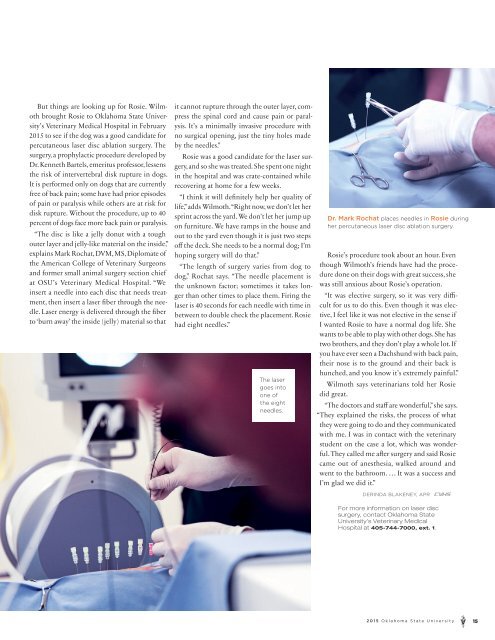Vet Cetera magazine 2015
Official magazine of the Center for Veterinary Health Sciences at Oklahoma State University
Official magazine of the Center for Veterinary Health Sciences at Oklahoma State University
You also want an ePaper? Increase the reach of your titles
YUMPU automatically turns print PDFs into web optimized ePapers that Google loves.
But things are looking up for Rosie. Wilmoth<br />
brought Rosie to Oklahoma State University’s<br />
<strong>Vet</strong>erinary Medical Hospital in February<br />
<strong>2015</strong> to see if the dog was a good candidate for<br />
percutaneous laser disc ablation surgery. The<br />
surgery, a prophylactic procedure developed by<br />
Dr. Kenneth Bartels, emeritus professor, lessens<br />
the risk of intervertebral disk rupture in dogs.<br />
It is performed only on dogs that are currently<br />
free of back pain; some have had prior episodes<br />
of pain or paralysis while others are at risk for<br />
disk rupture. Without the procedure, up to 40<br />
percent of dogs face more back pain or paralysis.<br />
“The disc is like a jelly donut with a tough<br />
outer layer and jelly-like material on the inside,”<br />
explains Mark Rochat, DVM, MS, Diplomate of<br />
the American College of <strong>Vet</strong>erinary Surgeons<br />
and former small animal surgery section chief<br />
at OSU’s <strong>Vet</strong>erinary Medical Hospital. “We<br />
insert a needle into each disc that needs treatment,<br />
then insert a laser fiber through the needle.<br />
Laser energy is delivered through the fiber<br />
to ‘burn away’ the inside (jelly) material so that<br />
it cannot rupture through the outer layer, compress<br />
the spinal cord and cause pain or paralysis.<br />
It’s a minimally invasive procedure with<br />
no surgical opening, just the tiny holes made<br />
by the needles.”<br />
Rosie was a good candidate for the laser surgery,<br />
and so she was treated. She spent one night<br />
in the hospital and was crate-contained while<br />
recovering at home for a few weeks.<br />
“I think it will definitely help her quality of<br />
life,” adds Wilmoth. “Right now, we don’t let her<br />
sprint across the yard. We don’t let her jump up<br />
on furniture. We have ramps in the house and<br />
out to the yard even though it is just two steps<br />
off the deck. She needs to be a normal dog; I’m<br />
hoping surgery will do that.”<br />
“The length of surgery varies from dog to<br />
dog,” Rochat says. “The needle placement is<br />
the unknown factor; sometimes it takes longer<br />
than other times to place them. Firing the<br />
laser is 40 seconds for each needle with time in<br />
between to double check the placement. Rosie<br />
had eight needles.”<br />
The laser<br />
goes into<br />
one of<br />
the eight<br />
needles.<br />
Dr. Mark Rochat places needles in Rosie during<br />
her percutaneous laser disc ablation surgery.<br />
Rosie’s procedure took about an hour. Even<br />
though Wilmoth’s friends have had the procedure<br />
done on their dogs with great success, she<br />
was still anxious about Rosie’s operation.<br />
“It was elective surgery, so it was very difficult<br />
for us to do this. Even though it was elective,<br />
I feel like it was not elective in the sense if<br />
I wanted Rosie to have a normal dog life. She<br />
wants to be able to play with other dogs. She has<br />
two brothers, and they don’t play a whole lot. If<br />
you have ever seen a Dachshund with back pain,<br />
their nose is to the ground and their back is<br />
hunched, and you know it’s extremely painful.”<br />
Wilmoth says veterinarians told her Rosie<br />
did great.<br />
“The doctors and staff are wonderful,” she says.<br />
“They explained the risks, the process of what<br />
they were going to do and they communicated<br />
with me. I was in contact with the veterinary<br />
student on the case a lot, which was wonderful.<br />
They called me after surgery and said Rosie<br />
came out of anesthesia, walked around and<br />
went to the bathroom. … It was a success and<br />
I’m glad we did it.”<br />
DERINDA BLAKENEY, APR<br />
For more information on laser disc<br />
surgery, contact Oklahoma State<br />
University’s <strong>Vet</strong>erinary Medical<br />
Hospital at 405-744-7000, ext. 1.<br />
<strong>2015</strong> Oklahoma State University 15


